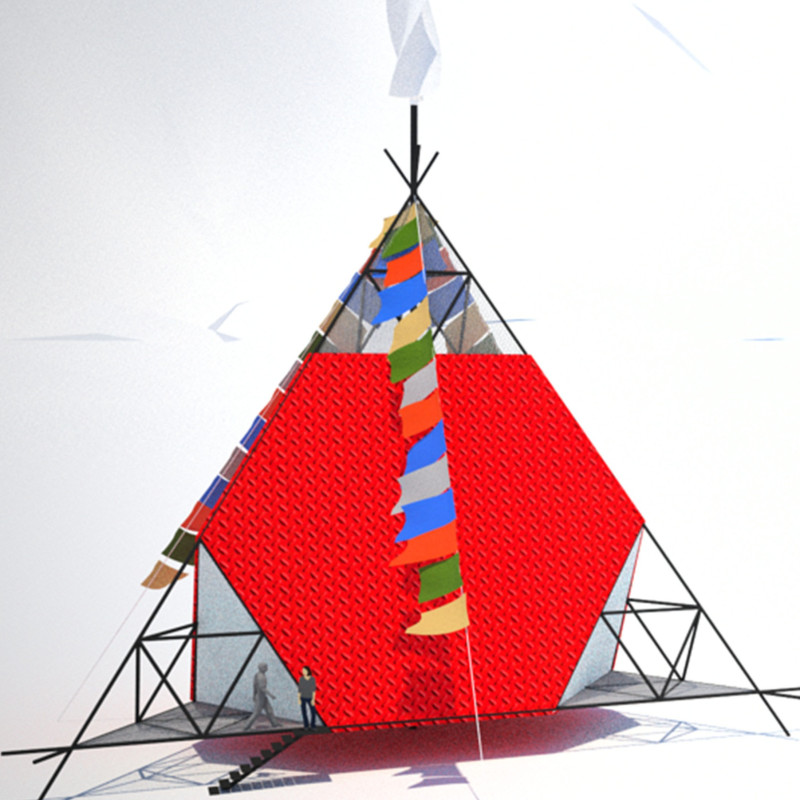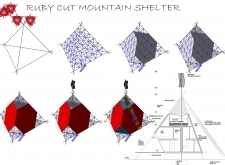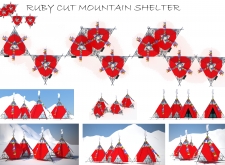5 key facts about this project
From a functional standpoint, the Ruby Cut Mountain Shelter is organized into distinct zones that cater to various activities. A central living area promotes social interaction, allowing users to gather comfortably. Surrounding this communal space are well-planned sleeping quarters, designed to ensure both privacy and comfort. A dedicated technical area showcases the integration of essential utilities, enabling the shelter to operate autonomously. The design effectively maximizes available space, providing a seamless flow between public and private areas.
Unique design approaches are clearly evident throughout the Ruby Cut Mountain Shelter, particularly in its structural choices. The use of a lightweight aluminum framework establishes a balance between durability and ease of assembly, aligning with the project's philosophy of adaptability. The shelter's pneumatic walls offer flexibility and thermal performance, allowing the structure to respond dynamically to the surrounding environment. These elements not only reinforce the shelter's physical integrity but also underscore a commitment to innovation in architectural design.
Furthermore, the Ruby Cut Mountain Shelter highlights its dedication to sustainability through an array of eco-friendly technologies. Water catchment systems are incorporated to efficiently utilize rainwater, reducing reliance on external resources. Solar panels strategically positioned to harness sunlight contribute to the shelter’s energy needs, while an integrated wind turbine enhances its renewable energy capabilities. These features exemplify a contemporary approach to architecture that prioritizes environmental responsibility without sacrificing user comfort.
Geographically, the shelter is situated in a mountainous region, where its aerodynamic shape is designed to withstand the elements effectively. The design respects the natural landscape, with its triangular forms echoing the surrounding peaks. This contextual awareness is vital, as it enables the structure to coexist harmoniously with its environment, embodying a philosophy of architecture that respects and enhances the natural world.
The Ruby Cut Mountain Shelter serves not just as a physical shelter but as a community hub that encourages interaction and togetherness. The organization of spaces fosters social connectivity, allowing diverse groups to engage meaningfully. This design strategy reflects an understanding of how architecture can shape human experience and promote communal resilience.
In terms of architectural details, the project employs a cohesive material palette that reinforces its design intent. The incorporation of ETFE panels ensures ample natural light while maintaining thermal efficiency, aptly supporting the shelter's functional requirements. The use of solar shielding panels further enhances the structure's energy efficiency, reflecting a comprehensive understanding of modern building technologies.
The Ruby Cut Mountain Shelter is a robust and considered architectural project that offers a unique interpretation of living within the mountainous landscape. Through its focus on sustainability, innovative design approaches, and community engagement, it provides a model for future projects in similar contexts. To gain deeper insights into the architectural plans, sections, and overall design ideas that inform this project, readers are encouraged to explore the detailed project presentation available. The thoughtful intricacies of the Ruby Cut Mountain Shelter invite further exploration and highlight possibilities for architectural innovation in harmony with nature.


























